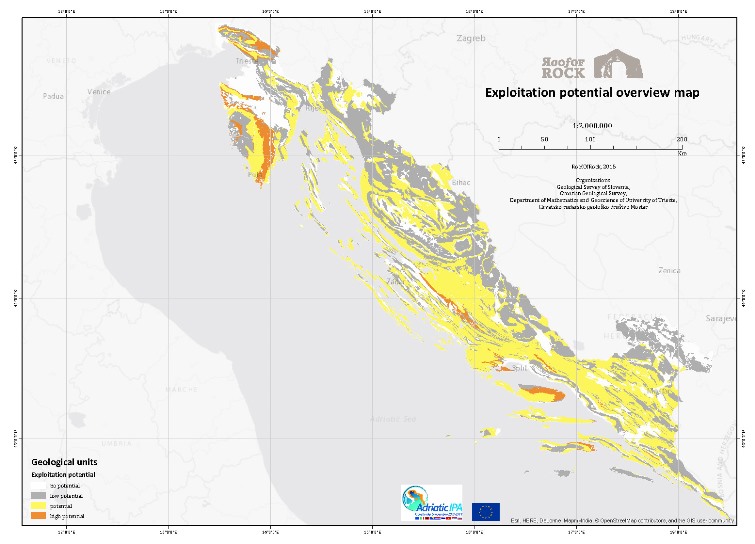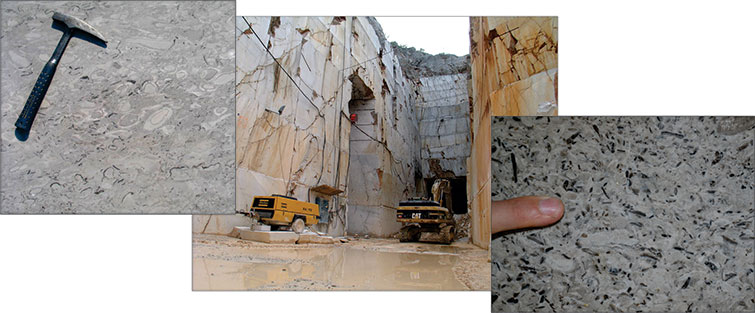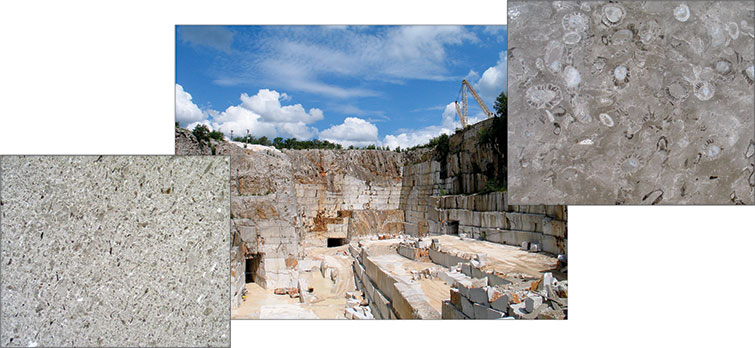Platy limestone – geologic definition and its use as a mineral commodity
Jernej Jež, Uroš Barudžija, Sara Biolchi, Stefano Devoto, Goran Glamuzina, Tvrtko Korbar
In the Adriatic karst area, limestone has always played a crucial role in the cultural heritage, landscape and economy of this area. The region still contains huge reserves of very diverse natural stones which could represent an important economic and architectural resource. Due to the mechanical properties and diversity of the different limestone types, the area has been associated with the quarrying and manufacturing of stone for over two thousand years, since Roman times. Smaller or larger quarries were once almost an unavoidable component of every village. People knew and used a number of different types of limestone that differed in quality, colour and structure. The extraction of limestone, which was once important economic activity of the local people, has gradually decreased in the last few decades.
During the first project activity, more than 80 of the most important types of building limestone in the entire RoofOfRock project area were evidenced along with more than 200 typical quarries of building limestone (Map 2.1) (see Appendices 2.1, 2.2, 2.3 and 2.4). In the project area in Herzegovina, 20 important building limestone types and 27 typical quarries have been documented, in Croatia 40 types and 74 quarries, in Slovenia 15 types and more than 45 quarries, and 8 limestone types and approx. 100 typical quarries in Italy. All acquired data have been recorded in the GIS-based database and can be accessed with the project web-application.

The most important types of building limestone occur in the north-western part of the project area in Bosnia and Herzegovina. Massive building limestone and limestone-dolomitic breccias are suitable for exploitation of bigger limestone blocks. A large area with massive and thick-bedded, mostly grained, bioclastic Cretaceous limestone also has a very high potential for exploitation of irregular blocks known as 'tombolons'. Therefore, many quarries in the project area in Herzegovina have been using this method of exploitation of irregular blocks, which have been processed after quarrying.
In the project area in Croatia the most important high potential building limestone types occur in Istria and Dalmatia (Map 2.2). In Istria they are represented by thick-bedded to massive limestone types: Upper Jurassic mostly light grey micritic limestone, yellowish micritic Lower Cretaceous limestone and whitish Upper Cretaceous bioclastic grainy limestone. The first are exposed in the western part of Istria, while the other two types occur in central, southern and northern parts of Istria. In the area of central and southern Dalmatia, significant occurrences of natural stones are known from the hinterland of Šibenik and Split, from a wider area of Trogir and from northern and eastern parts of the islands of Brač and Korčula. Furthermore, in these areas, limestone types are mostly represented by thick bedded to massive Upper Cretaceous grained bioclastic lithotypes with rudist bivalves. In northern Dalmatia (the Benkovac area north of Zadar), there is a surface occurrence of economically important thin-bedded fine-grained limestone to clayey limestone and alternation with calcarenite, calcisiltite and calcilutite.

The Kras/Carso region in Italy and Slovenia also has a long history of quarrying and manufacturing high-quality limestone. The limestone rocks and dolomites of the area were divided into various geological units with different names on the both sides of the border (e.g. Povir/Monrupino Formation, Repen/Zolla Fm., Sežana/Lower Aurisina Fm.) (see Appendices 2.1 and 2.2). By far the most important geological units for quarrying the architectonic-building limestone are the Repen/Zolla and the Lipica/Upper Aurisina Formations. The Repen/Zolla Formation consists of Cenomanian and Turonian mostly grained rudist bioclastic limestones among which the high‐quality natural stone of Repen (Repen Classico) or Kopriva type occur (Fig. 2.1). The classical Repen stone is of great economic importance and is being exploited in many quarries in the Italian and Slovenian territory. The Lipica/Upper Aurisina Formation of Santonian to Campanian age is represented by several types of bedded and massive limestone with prevailing bioclastic varieties. Rudist shells of different size, colour, shape and distribution give the rock its specific appearance and character. This unit contains high‐quality natural stone represented by two characteristic limestone types: uniform stone – Lipica unito and rosy stone – Lipica fiorito (Fig. 2.2). In the famous Aurisina exploitation area in the Italian part of the project area, a variety of limestone types from the Lipica/Upper Aurisina Fm. are known: Aurisina Chiara, Aurisina Fiorita, Aurisina Granitello, Roman Stone.











